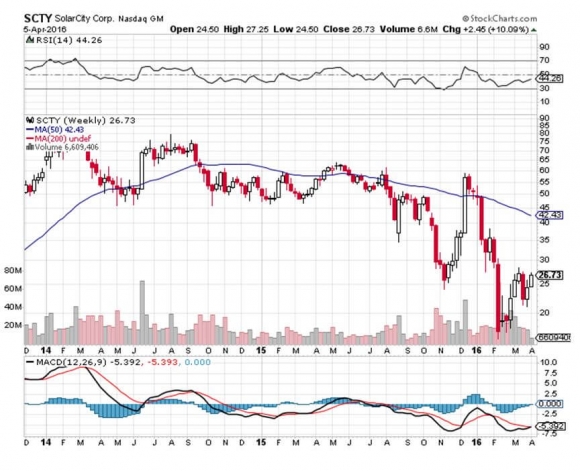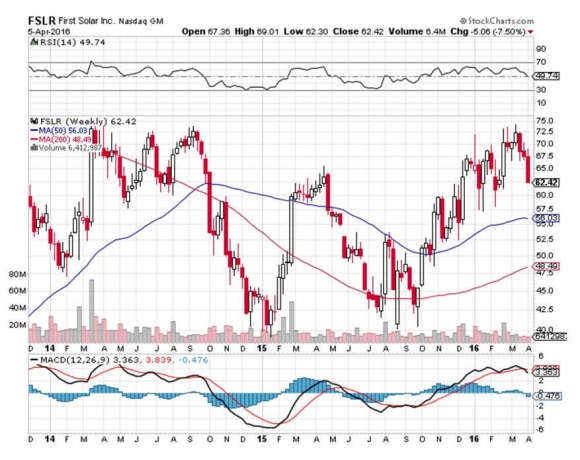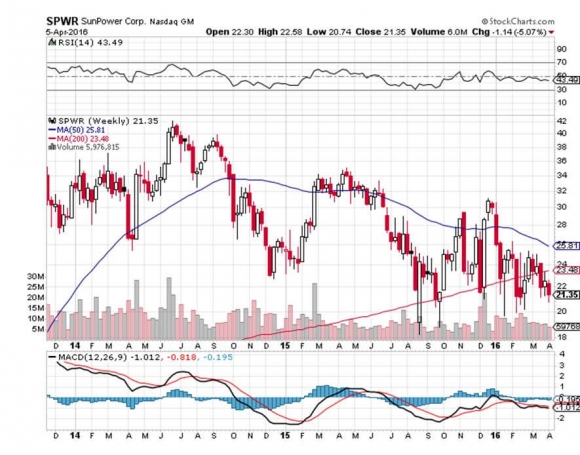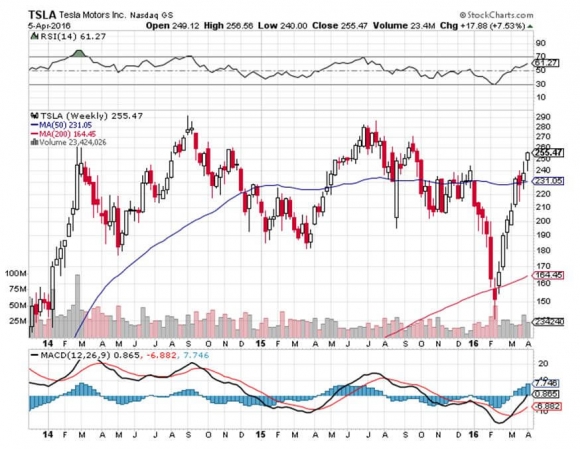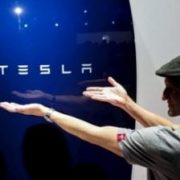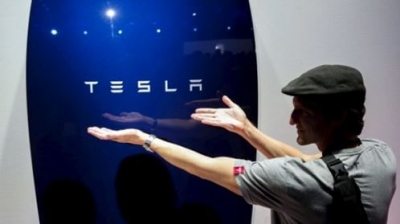I have seen the future, and it works.
In my never-ending search for my readers for ?ten-baggers,? or investments that will rise in value tenfold over the foreseeable future, I keep circling back to the solar industry.
Tesla founder Elon Musk never does anything small.
Last year he announced the first ever, economical home battery electrical storage system, which he calls the Powerwall.
The device will enable your roof-mounted solar panels to supply power to your home 24 hours a day, not just when the sun is shining.
It is an innovation on the scale of Thomas Edison?s invention of the light bulb in 1879, or the launch of the Internet in 1969, in terms of the long-term impact on our economy.
Shifting the source of a third of our power supply is a big deal.
You may recall that the early investors in these earlier transitions made fortunes, General Electric (GE) in Edison?s case, and Netscape that spun out of the early Internet days.
Today, General Electric is the only company that has remained in the Dow Average for the past 100 years. So, investors take note.
During the day, the panels will charge up the battery mounted on your garage wall, which is about the size of a big screen TV. At night, you can then run your home off battery power.
Alternatively, you can engage in what is known in the industry as ?load shifting.? Charge your battery at night when you can buy electricity for as little as 4 cents a kilowatt hour, and sell it back to your local utility during a power demand surge the next afternoon for as much as 50 cents a kWh.
Buy low, sell high, it works for me!
And what is the cost of the miracle technology?
Only $3,000 for a 7 kWh battery or $3,500 for the 10 kWh version for energy hogs, like me, who has to charge a Tesla Model S-1 every day, soon to be two.
You can also include as immediate customers for this new product sports addicts, who watch multiple games on ESPN 24/7, paranoids who keep the lights on all night and indoor pot farmers, whose energy needs are said to be prodigious. Of course, the military will be another big consumer.
I ran some numbers on the possibilities for the Powerwall and they are mind-boggling.
The average home in the US has 2,500 square feet, which uses 7,000 kWh per year, or 19 kWh per day. The current cost for this power will be around $2,000 a year, depending where you live, more in California, and less in Texas, Oklahoma, and North Carolina.
A solar/ battery combination for such a home should cost about $14,000, including installation, the panels, the inverter, and all the gizmos. Net out the alternative energy investment tax credit of 30% (IRS Form 5695 http://www.irs.gov/pub/irs-pdf/f5695.pdf ), and your cost falls to only $10,500.
That means your power savings will cover the cost of your solar investment in a mere 5 years, compared to the present 7 or 8 years. After that, your home will have free electricity for another 20 years, as the life of these systems is usually 25 years.
Make the investment, and the value of your home rises, by $2 for every dollar spent, or so local real estate agents tell me.
You also will be guaranteed against any future power rate increases, an absolute certainty. America?s power grid is currently in a woeful state of disrepair, with much of the hardware 50 years old, or more.
The demands on the power industry are also about to take a quantum leap forward, as millions of consumers buy electric cars. Tesla plans to ramp up production of vehicles from 40,000 units last year to 500,000 by 2020, when the $35,000, 300 mile range Tesla 3 achieves mass production.
Some of my over-the-horizon-thinking hedge fund friends believe that figure could hit 15 million by 2030.
Add to that new, competing electric models produced by every other major carmaker, and that?s a lot of juice that will be needed. As a result, electric power utilities will probably have to endure more structural changes to their business model than any other industry.
Trillions of dollars are needed to modernize it, and all of that is going to come out of your pocket, but only if you remain an existing power customer.
Indeed, I have already been notified by my own utility, Pacific Gas and Electric Company (PGE), that I am due for two consecutive 7% price increases over the next two years.
The battery will also provide a backup power supply for home for when the grid crashes. Twice in the last two decades I have lost a freezer full of venison, pheasants, quail, trout, and salmon that I hunted and fished when storms knocked out power, for a week each time.
The Powerwall prices are so low that they beat the cost of a conventional backup diesel or gasoline generator.
They will also wipe out most of the existing back up battery industry, as Tesla?s advantages gained through massive economies of scale are enormous. Musk is talking about producing billions of batteries.
The Powerwall is a game changer for the solar industry, which has long been hobbled by the limitation that it could only supply power for 12 hours a day, and less in the winter, depending on your latitude.
It certainly gives a shot in the arm for the solar industry, which I have been banging the table about for years. My favorite is Solar City (SCTY). Other names to look at are First Solar (FSLR) and SunPower (SPWR), which manufactures my own solar panels.
It also casts Musk?s own Tesla (TSLA) in a new light. It is no longer just a car company, but a comprehensive energy solution. Musk has already made one of the largest capital investments in history to build a $5 billion ?Giga? factory near Reno, Nevada.
Much of that plant?s production has already been pre sold, and I understand that the decision has already been made to build a second one. Wow!
Consumers are able to purchase the new batteries from the Texas based retailer, TreeHouse, (their link https://treehouse.co/treehouse-is-first-retailer-to-sell-tesla-home-battery/ ).
Musk explains that the world consumes 20 trillion kWh per year of electricity.
In the US, 1/3 of our fossil fuel consumption goes to transportation, and another 1/3 generates electric power, which is the equivalent to consuming 225 billion gallons of gasoline per year (or 8 billion barrels of oil per year, or 22 million barrels a day).
His goal is nothing less than to largely substitute those fossil fuel uses with solar energy, cutting our fossil fuel consumption by 2/3.
I guess there is no point in setting the bar low.
